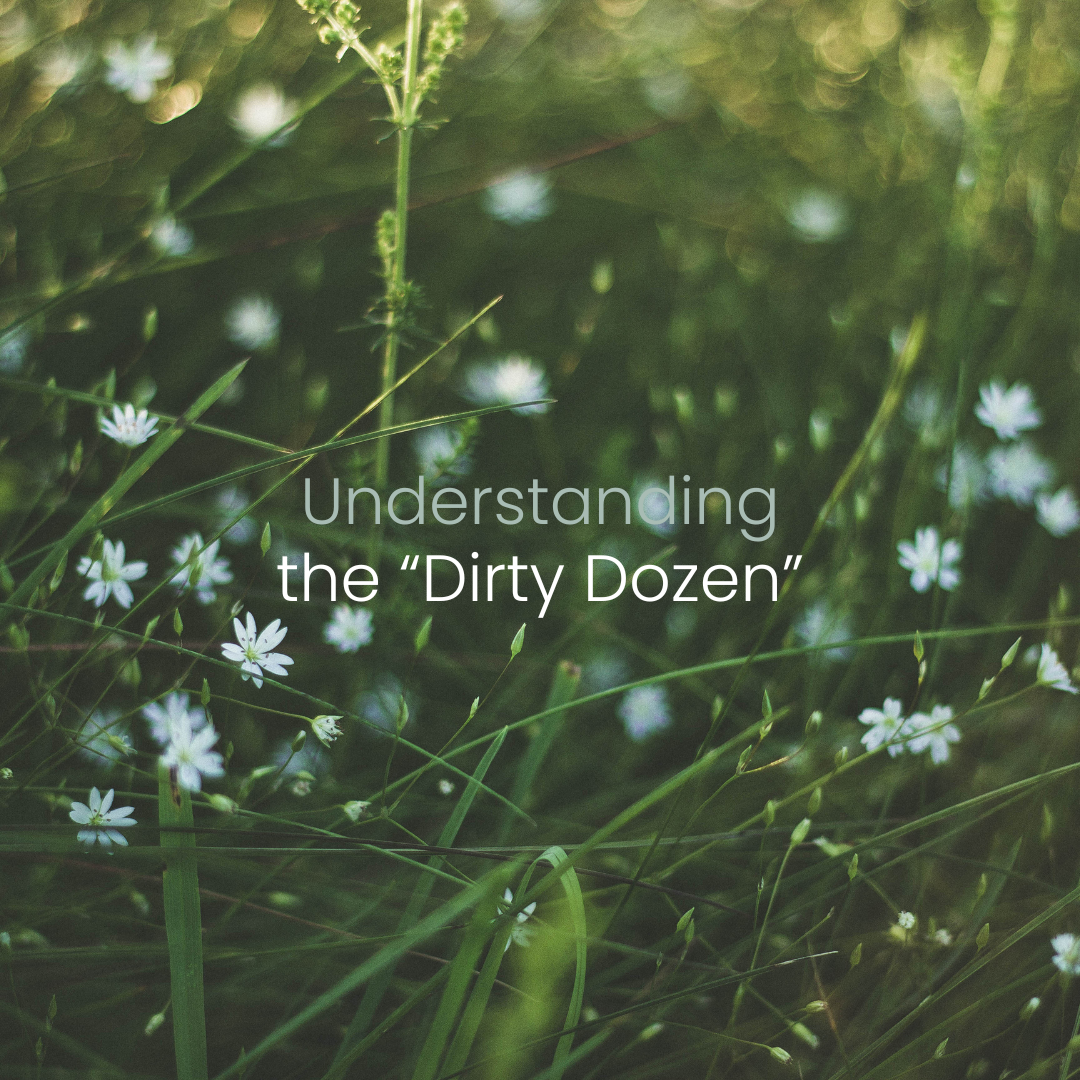Understanding the “Dirty Dozen” Chemicals in Mainstream Personal Care Products

Understanding the “Dirty Dozen” Chemicals in Mainstream Personal Care Products
Are you familiar with the “Dirty Dozen” ingredients commonly found in mainstream personal care products? These synthetic chemicals are associated with a range of health risks, including cancer, hormone disruption, and reproductive issues. Additionally, some of these chemicals resist degradation, lingering in the environment long after they’ve been rinsed down the drain. Let’s dive deeper into what these chemicals are and why you should avoid them.
The Dirty Dozen: A Closer Look
BHA and BHT
Usage: Preservatives in cosmetics and skincare products.
Risks: Can cause skin allergies and have potential endocrine-disrupting properties, interfering with hormone functions.
Sodium Laureth Sulfate
Usage: Common surfactant in shampoos, body washes, and toothpastes.
Risks: Can be contaminated with carcinogenic by-products like 1,4-dioxane.
Coal Tar Dyes
Identification: Look for p-Phenylenediamine and colors listed as “CI” followed by a five-digit number.
Risks: These dyes can be carcinogenic and cause skin irritation.
Parabens
Usage: Widely used as preservatives in cosmetics and personal care products.
Risks: Can mimic estrogen and disrupt hormone function, potentially leading to breast cancer and reproductive issues.
Parfum (a.k.a. Fragrance)
Usage: Added to products to provide scent.
Risks: Often a blend of many chemicals, some of which can cause allergies, hormone disruption, and other health issues.
DEA-related Ingredients
Usage: Found in creamy and foaming products like moisturizers and shampoos.
Risks: Can react with other ingredients to form carcinogenic nitrosamines.
Dibutyl Phthalate
Usage: Commonly used in nail products.
Risks: Can disrupt hormones and affect reproductive health.
Formaldehyde-releasing Preservatives
Usage: Used to prevent microbial growth in personal care products.
Risks: Can release small amounts of cancer-causing formaldehyde over time.
PEG Compounds
Usage: Found in many cream-based cosmetics.
Risks: Can be contaminated with carcinogenic substances like ethylene oxide and 1,4-dioxane.
Petrolatum
Usage: Used in hair care and skin care products.
Risks: Can be contaminated with carcinogenic polycyclic aromatic hydrocarbons (PAHs).
Siloxanes
Usage: Found in cosmetics to soften, smooth, and moisten.
Risks: Some siloxanes can be toxic and disrupt endocrine functions.
Triclosan
Usage: An antimicrobial agent in soaps and hand sanitizers.
Risks: Can contribute to antibiotic resistance and disrupt thyroid function.
Taking Charge of Your Beauty Routine
To protect your health and the environment, consider choosing natural products that are free from these harmful chemicals. At Pure Earth, we are committed to providing products that honor natural living and sustainability, free from the “Dirty Dozen” chemicals. Our products, like the Pure Kakadu Plum Facial Serum, are crafted with pure botanical extracts, ensuring they are safe and effective.
By opting for natural, toxin-free products, you can reduce your exposure to harmful chemicals and contribute to a healthier planet.
References:
Are all “personal care products” regulated as cosmetics? U.S. Food & Drug Administration.
https://www.fda.gov/forindustry/fdabasicsforindustry/ucm238796.htm. Published 2016. Accessed January 30, 2019.[1]
FDA Authority Over Cosmetics: How Cosmetics Are Not FDA-Approved, but Are FDA-Regulated. U.S. Food & Drug Administration.
https://www.fda.gov/Cosmetics/GuidanceRegulation/LawsRegulations/ucm074162.htm. Published 2013. Accessed January 30, 2019.[2]
EWG | About Us. https://www.ewg.org/about-us. Accessed January 30, 2019.[3]
Exposures add up – Survey results | Skin Deep® Cosmetics Database | EWG.
https://www.ewg.org/skindeep/2004/06/15/exposures-add-up-survey-results/. Accessed January 28, 2019.[4]
EWG’s 2018 Shopper’s Guide to Pesticides in Produce | Dirty Dozen. https://www.ewg.org/foodnews/dirty-dozen.php. Accessed January 30, 2019.[5]
The “Dirty Dozen” Ingredients Investigated in The David Suzuki Foundation Survey of Chemicals in Cosmetics.; 2010. https://davidsuzuki.org/wp-content/uploads/2010/10/dirty-dozen- BACKGROUNDER.pdf. Accessed January 31, 2019.[6]
Our Work – David Suzuki Foundation. https://davidsuzuki.org/our-work/. Accessed January 31, 2019.[8]
Gue L. A Survey of Toxic Ingredients in Our Cosmetics.; 2010. www.davidsuzuki.org/publications. Accessed January 31, 2019.[9]
Ingredients – Fragrances in Cosmetics. U.S. Food & Drug Administration. https://www.fda.gov/Cosmetics/ProductsIngredients/Ingredients/ucm388821.htm. Published 2018. Accessed January 31, 2019.[10]
Press Announcements – FDA issues final rule on safety and effectiveness of antibacterial soaps. U.S. Food & Drug Administration.
https://www.fda.gov/newsevents/newsroom/pressannouncements/ucm517478.htm. Published 2016. Accessed January 31, 2019.[11]
Browse Products || Skin Deep® Cosmetics Database | EWG. Environmental Working Group. https://www.ewg.org/skindeep/browse.php?containing=706623&&showmore=products&start=30. Accessed January 31, 2019.[12]
Labeling Claims – “Organic” Cosmetics. U.S. Food & Drug Administration. https://www.fda.gov/cosmetics/labeling/claims/ucm203078.htm. Published 2018. Accessed January 31, 2019.[13]
Skin Deep® Cosmetics Database | EWG. https://www.ewg.org/skindeep/. Accessed January 31, 2019.[14]